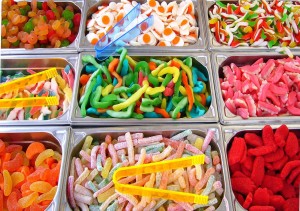We all know it is nearly impossible to tear a child away from something sweet. Sugary foods and drinks can be a foolproof go to for any frazzled parent who needs their toddler to sit still. But have you ever wondered why children have this insatiable desire for all things sweet? Well, simply put, blame biology!
W hile media in the western world bombards youth with advertisements for sweets, science has found that this may only play a minor role in a child’s desire to consume sugary food and drink. Youth worldwide, regardless of exposure to sugar ad campaigns are inclined to crave sweet tastes so it can’t all be because of marketing. So let’s get the dirt (or should I say decay?) on the sweet tooth.
hile media in the western world bombards youth with advertisements for sweets, science has found that this may only play a minor role in a child’s desire to consume sugary food and drink. Youth worldwide, regardless of exposure to sugar ad campaigns are inclined to crave sweet tastes so it can’t all be because of marketing. So let’s get the dirt (or should I say decay?) on the sweet tooth.
Naturally, sugars are carbohydrates and carbohydrates are a good source of quick energy. Babies are born with a preference for sugar because, biologically, sugar means energy. Energy for what? Well, to grow! The craving for sweets ensures that babies will accept nutrient dense foods like their mother’s milk and fruits after being born.
Interestingly, research has not only found that naturally intense sweet tastes are preferred among growing children but that sugar actually makes kids feel better, too! Research suggests that sugar is a natural pain reliever(PDF) and a drop of a sugary solution on the tongue is being used more and more in neonatal procedures like circumcisions to lessen pain.
 So how much sweet is too much? To adults, usually the sweetness of a can of soda is about all we can handle but for growing children? Try double that flavor(PDF). Typically, tastes change and youth around 15 or 16 start to develop preferences similar to adults.
So how much sweet is too much? To adults, usually the sweetness of a can of soda is about all we can handle but for growing children? Try double that flavor(PDF). Typically, tastes change and youth around 15 or 16 start to develop preferences similar to adults.
So how does this work and why do we change? Science is still up in the air about that one. Dr. Sue Coldwell, a researcher at the University of Washington, suspects it is related to hormones. One study she conducted found that adolescents who were still growing, measured by bone growth markers in urine, were more inclined to prefer sweeter sweets than those who were finished (or slowed) growing. A study at Columbia University found that bones secrete hormones that influence metabolism. Coldwell believes these hormones may also work like insulin and be tied to cravings in the brain or tongue to signal “sugar means energy so eat up!”
 All this science made sense evolutionarily in a world where food was scarce and calories were hard to come by. The problem in our current day and age, however, is calories are more than readily available so that sweet tooth may no longer be an evolutionary advantage but rather an instinct in need of extinction.
All this science made sense evolutionarily in a world where food was scarce and calories were hard to come by. The problem in our current day and age, however, is calories are more than readily available so that sweet tooth may no longer be an evolutionary advantage but rather an instinct in need of extinction.
Regardless, it is important to recognize the biology of the sweet tooth in order to effectively develop ways of reducing sugar intake in youth. In the meantime, don’t get too upset when your child asks for extra sugar in their cereal, it’s just a sign that they are a growing kid!

